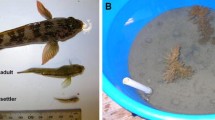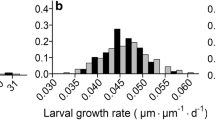Abstract
Phenotypic variability within cohorts of juvenile organisms can serve as the basis for selective mortality. Previous studies have demonstrated the important role that predators play in this process but not the impact of competitors on selective predation. We use a combination of lab and field studies to evaluate the effect of the presence of adult competitor damselfish (Dascyllus aruanus and Pomacentrus moluccensis; family Pomacentridae) on the selective mortality of newly-arrived (settled) lemon damselfish (P. moluccensis) by resident predator fishes (Pseudochromis fuscus Pseudochromidae and Cheilodipterus quinquelineatus Apogonidae). Lab trials consisted of mesocosm experiments in which the behaviour, mortality, and physiological condition (measured as lipid content) of surviving P. moluccensis settlers from each of three treatments: (1) predators absent, (2) predators present, and (3) predators and competitors present, were compared. The field study involved stocking newly settled P. moluccensis on natural bommies (patch reefs) which had either been subject to a partial removal of resident fish (predators and competitors) or left alone. Results indicated there was very strong condition-based selective mortality in both the lab and field trials. In both cases there was a strong positive relationship between mortality and the lipid content of surviving fish; implying low-condition fish were selectively removed. The mesocosm trials indicated that the strength of mortality as well as condition selectivity was higher when competitors were present than when they were absent. Behavioural observations in the mesocosm study suggest that attention by juvenile P. moluccensis to the movements and occasional chases of the competitors (especially D. aruanus) reduced their vigilance to the predators. These results suggest the important and interactive roles which condition of newly settled reef fish and interspecific competition can play in the outcomes of post-settlement predation.




Similar content being viewed by others
Reference
Almany GR (2004a) Differential effects of habitat complexity, predators and competitors on abundance of juvenile and adult coral reef fishes. Oecologia 141:105–113
Almany GR (2004b) Does increased habitat complexity reduce predation and competition in coral reef fish assemblages? Oikos 106:275–284
Almany GR (2004c) Priority effects in coral reef fish communities of the Great Barrier Reef. Ecology 85:2872–2880
Almany GR, Webster MS (2006) The predation gauntlet: early post-settlement mortality in reef fishes. Coral Reefs 25:19–22
Beukers JS, Jones GP (1998) Habitat complexity modifies the impact of piscivores on a coral reef fish population. Oecologia 114:50–59
Bligh K, Dyer D (1959) A simple extraction method for tissue lipids. J Comp Biochem 15:27–43
Booth D, Alquezar R (2002) Food supplementation increases larval growth, condition and survival of Acanthochromis polyacanthus. J Fish Biol 60:1126–1133
Booth DJ, Beretta GA (2004) Influence of recruit condition on food competition and predation risk in a coral reef fish. Oecologia 140:289–294
Booth DJ, Hixon MA (1999) Food ration and condition affect early survival of the coral reef damselfish, Stegastes partitus. Oecologia 121:364–368
Brown GE (2003) Learning about danger: chemical alarm cues and local risk assessment in prey fishes. Fish Fish 4:227–234
Brunton BJ, Booth DJ (2003) Density- and size-dependent mortality of a settling coral-reef damselfish (Pomacentrus moluccensis Bleeker). Oecologia 137:377–384
Caley MJ, Carr MH, Hixon MA, Hughes TP, Jones JP, Menge BA (1996) Recruitment and the local dynamics of open marine populations. Annu Rev Ecol Syst 27:477–500
Carey C, Bryant CJ (1995) Possible interrelations among environmental toxicants, amphibian development, and decline of amphibian populations. Environ Health Perspect 103:13–17
Carr MH, Anderson TW, Hixon MA (2002) Biodiversity, population regulation, and the stability of coral-reef fish communities. Proc Natl Acad Sci USA 99:11241–11245
Chase JM et al (2002) The interaction between predation and competition: a review and synthesis. Ecol Lett 5:302–315
Diamond J, Case TJ (1986) Community ecology. Harper & Row, New York
Finn MD, Kingsford MJ (1996) Two-phase recruitment of apogonids (Pisces) on the Great Barrier Reef. Mar Freshwater Res 47:423–432
Gagliano M, McCormick MI (2007a) Compensating in the wild: is flexible growth the key to early juvenile survival? Oikos 116:111–120
Gagliano M, McCormick MI (2007b) Maternal condition influences phenotypic selection on offspring. J Anim Ecol 76:174–182
Green BS, McCormick MI (2005) Maternal and paternal effects determine size, growth and performance in larvae of a tropical reef fish. Mar Ecol Prog Ser 289:263–272
Gurevitch J, Morrison JA, Hedges LV (2000) The interaction between competition and predation: a meta-analysis of field experiments. Am Nat 155:435–453
Hixon MA, Carr MH (1997) Synergistic predation, density dependence, and population regulation in marine fish. Science 277:946–949
Hixon MA, Jones GP (2005) Competition, predation, and density-dependent mortality in demersal marine fishes. Ecology 86:2847–2859
Hoey AS, McCormick MI (2004) Selective predation for low body condition at the larval-juvenile transition of a coral reef fish. Oecologia 139:23–29
Holbrook SJ, Schmitt RJ (2002) Competition for shelter space causes density-dependent predation mortality in damselfishes. Ecology 83:2855–2868
Holmes TH, McCormick MI (2006) Location influences size-selective predation on newly settled reef fish. Mar Ecol Prog Ser 317:203–209
Holt RD (1977) Predation, apparent competition, and the structure of prey communities. Theor Popul Biol 12:197–229
Huntingford FA, Chellappa S, Taylor AC, Strang RHC (2001) Energy reserves and reproductive investment in male three-spined sticklebacks, Gasterosteus aculeatus. Ecol Freshwater Fish 10:111–117
Jeffries MJ, Lawton JH (1984) Enemy free space and the structure of ecological communities. Biol J Linn Soc 23:269–286
Jeffries MJ, Lawton JH (1985) Predator–prey ratios in communities of fresh-water invertebrates—the role of enemy free space. Freshwater Biol 15:105–112
Kerrigan BA (1996) Temporal patterns in size and condition at settlement in two tropical reef fishes (Pomacentridae: Pomacentrus amboinensis and P-nagasakiensis). Mar Ecol Prog Ser 135:27–41
Kobayashi DR (2006) Colonization of the Hawaiian Archipelago via Johnston Atoll: a characterization of oceanographic transport corridors for pelagic larvae using computer simulation. Coral Reefs 25:407–417
Kritzer JP, Sale PF (2004) Metapopulation ecology in the sea: from Levins’ model to marine ecology and fisheries science. Fish Fish 5:131–140
Mann R, Gallagher SM (1985) Physiological and biochemical energetics of larvae of Teredo navalis and Bankia gouldi. J Exp Mar Biol Ecol 85
Marnane MJ, Bellwood DR (2002) Diet and nocturnal foraging in cardinalfishes (Apogonidae) at One Tree Reef, Great Barrier Reef, Australia. Mar Ecol Prog Ser 231:261–268
McCormick MI (1998) Condition and growth of reef fish at settlement: is it important? Austral Ecol 23:258–264
McCormick MI (2006) Mothers matter: crowding leads to stressed mothers and smaller offspring in marine fish. Ecology 87:1104–1109
McCormick MI, Holmes TH (2006) Prey experience of predation influences mortality rates at settlement in a coral reef fish, Pomacentrus amboinensis. J Fish Biol 68:969–974
McCormick MI, Meekan MG (2007) Social facilitation of selective mortality. Ecology 88:1562–1570
Meekan MG, Vigliola L, Hansen A, Doherty PJ, Halford A, Carleton JH (2006) Bigger is better: size-selective mortality throughout the life history of a fast-growing clupeid, Spratelloides gracilis. Mar Ecol Prog Ser 317:237–244
Munday PL, Eyre PJ, Jones GP (2003) Ecological mechanisms for coexistence of colour polymorphism in a coral-reef fish: an experimental evaluation. Oecologia 137:519–526
Murdoch WW (1994) Population regulation in theory and practice. Ecol Tempe 75:271–287
Nelson JS (2006) Fishes of the world. 4th edn. Wiley, Hoboken
Paris CB, Cowen RK, Claro R, Lindeman KC (2005) Larval transport pathways from Cuban snapper (Lutjanidae) spawning aggregations based on biophysical modeling. Mar Ecol Prog Ser 296:93–106
Pough F, Heiser J, McFarland W (1989) Vertebrate life, 3rd edn. MacMillan, New York
Roughgarden J, Gaines SD, Pacala SW (1987) Supply side ecology: the role of physical transport processes. In: Gee JHR, Giller PS (eds) Origanization of communitites past and present. Blackwell Scientific, Oxford
Sale PF (2004) Connectivity, recruitment variation, and the structure of reef fish communities. Integr Comp Biol 44:390–399
Schafer ML, Lundstrom JO (2006) Different responses of two floodwater mosquito species, Aedes vexans and Ochlerotatus sticticus (Diptera : Culicidae), to larval habitat drying. J Vector Ecol 31:123–128
Schmitt RJ (1987) Indirect interactions between prey–apparent competition, predator aggregation, and habitat segregation. Ecology 68:1887–1897
Sponaugle S, Grorud-Covert K (2006) Environmental variability, early life-history traits, and survival of new coral reef fish recruits. Integr Comp Biol 46:623–633
Sponaugle S, Pinkard D (2004) Lunar cyclic population replenishment of a coral reef fish: shifting patterns following oceanic events. Mar Ecol Prog Ser 267:267–280
Suthers IM (1998) Bigger? Fatter? Or is faster growth better? Considerations on condition in larval and juvenile coral-reef fish. Aust J Ecol 23:265–273
Twombly S, Tisch N (2002) Fitness consequences of the timing of metamorphosis in a freshwater crustacean. Oikos 97:213–222
Vergara JM, Robaina L, Izquierdo M, DeLaHiguera M (1996) Protein sparing effect of lipids in diets for fingerlings of gilthead sea bream. Fish Sci 62:624–628
Webster MS (2002) Role of predators in the early post-settlement demography of coral-reef fishes. Oecologia 131:52–60
Yodzis P (1978) Competition for space and the structure of ecological communities. Springer, Berlin
Zar JH (1984) Biostatistical analysis. 2nd edn, Prentice-Hall, New Jersey
Acknowledgements
The authors would like to thank P. Biro and C. Beckmann for assistance with field collections, S. Vandenbergh for help fabricating the mesocosm and G. Almany and three anonymous reviewers for their comments which have served to greatly improve this manuscript. This work was funded by an ARC Discovery Grant (DP0560005) to D. J. B. and conducted under permit from the Great Barrier Reef Marine Park Authority (G05/13485.1) and the Queensland Department of Primary Industries (PRM38983H). This is the Sydney Institute of Marine Sciences (SIMS) contribution number 0010.
Author information
Authors and Affiliations
Corresponding author
Additional information
Communicated by Roland Brandl.
Electronic supplementary material
Below is the link to the electronic supplementary material.
Rights and permissions
About this article
Cite this article
Figueira, W.F., Booth, D.J. & Gregson, M.A. Selective mortality of a coral reef damselfish: role of predator–competitor synergisms. Oecologia 156, 215–226 (2008). https://doi.org/10.1007/s00442-008-0985-2
Received:
Accepted:
Published:
Issue Date:
DOI: https://doi.org/10.1007/s00442-008-0985-2




